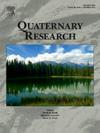Late Pleistocene Neanderthal exploitation of stable and mosaic ecosystems in northern Iberia shown by multi-isotope evidence
IF 1.8
3区 地球科学
Q3 GEOGRAPHY, PHYSICAL
引用次数: 1
Abstract
During the last glacial period, rapidly changing environments posed substantial challenges to Neanderthal populations in Europe. Southern continental regions, such as Iberia, have been proposed as important climatic “buffer” zones during glacial phases. Contextualising the climatic and ecological conditions Neanderthals faced is relevant to interpreting their resilience. However, records of the environments and ecosystems they exploited across Iberia exhibit temporal and spatial gaps in coverage. Here we provide new evidence for palaeotemperatures, vegetation structure, and prey herbivore ecology during the late Pleistocene (MIS 5–3) in northern Spain, by applying multiple stable isotope tracers (δ18O, δ13C, δ15N, δ34S) to herbivore skeletal remains associated with Neanderthal occupations at Axlor Cave, Bizkaia. The results show little change over time and indicate stable climatic conditions and ecosystems across different occupations. Large within-layer isotopic variability in nitrogen and sulphur suggests the presence of a mosaic environment and a variety of isotopic ecotones that were exploited by Neanderthals and their prey. We implement a combination of carbonate and phosphate δ18O measurements to estimate palaeotemperatures using a cost-effective workflow. We show that the targeted use of phosphate δ18O measurements to anchor summer peak and winter trough areas enables high-precision seasonal palaeoclimatic reconstructions.多同位素证据表明,晚更新世尼安德特人对伊比利亚北部稳定和马赛克生态系统的开发
在最后一个冰期,快速变化的环境给欧洲的尼安德特人带来了巨大的挑战。南部大陆地区,如伊比利亚,被认为是冰期重要的气候“缓冲带”。将尼安德特人所面临的气候和生态条件置于背景中,与解释他们的适应力有关。然而,他们在伊比利亚利用的环境和生态系统的记录显示出覆盖范围的时空差距。本文通过对西班牙北部阿克斯洛洞穴(Axlor Cave, Bizkaia)与穴居尼安德特人有关的草食动物骨骼遗骸进行δ18O、δ13C、δ15N、δ34S等稳定同位素示踪,为西班牙北部晚更新世(MIS 5-3)时期的古温度、植被结构和猎物草食动物生态提供新的证据。结果显示,随着时间的推移,气候条件和生态系统在不同的职业中几乎没有变化。氮和硫在层内的巨大同位素变化表明存在马赛克环境和各种同位素过渡带,这些环境被尼安德特人和他们的猎物所利用。我们采用了碳酸盐和磷酸盐δ18O测量相结合的方法来估算古温度。我们表明,有针对性地使用磷酸盐δ18O测量来锚定夏季高峰和冬季低谷区,可以实现高精度的季节性古气候重建。
本文章由计算机程序翻译,如有差异,请以英文原文为准。
求助全文
约1分钟内获得全文
求助全文
来源期刊

Quaternary Research
地学-地球科学综合
CiteScore
4.70
自引率
8.70%
发文量
57
审稿时长
3 months
期刊介绍:
Quaternary Research is an international journal devoted to the advancement of the interdisciplinary understanding of the Quaternary Period. We aim to publish articles of broad interest with relevance to more than one discipline, and that constitute a significant new contribution to Quaternary science. The journal’s scope is global, building on its nearly 50-year history in advancing the understanding of earth and human history through interdisciplinary study of the last 2.6 million years.
 求助内容:
求助内容: 应助结果提醒方式:
应助结果提醒方式:


